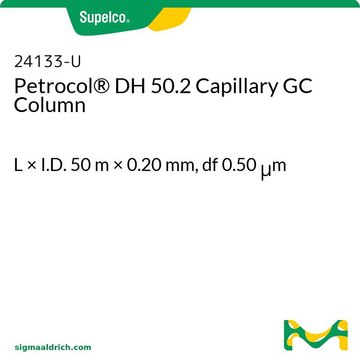24282
Petrocol® DH Octyl Capillary GC Column
L × I.D. 100 m × 0.25 mm, df 0.50 μm
About This Item
Recommended Products
material
fused silica
Agency
ASTM® D6729,D6730,D6773
parameter
-60-220 °C temperature (isothermal or programmed)
Beta value
125
df
0.50 μm
technique(s)
gas chromatography (GC): suitable
L × I.D.
100 m × 0.25 mm
matrix active group
Bonded; poly(50% n-octyl/50% methyl siloxane) phase
application(s)
chemicals and industrial polymers
petroleum
column type
capillary non-polar
General description
USP Code: None
Phase:
- Bonded
- Poly(50% n-octyl/50% methyl siloxane)
- -60 °C to 220 °C (isothermal or programmed)
Other Notes
Legal Information
Choose from one of the most recent versions:
Already Own This Product?
Find documentation for the products that you have recently purchased in the Document Library.
Related Content
Gas chromatography separates volatile compounds in the gas phase, applied in various industries for quality control.
Gas chromatography is a common analytic technique used to separate and analyze volatile compounds in the gas phase. GC is applied in many industries for quality control, and to identify and/or quantify compounds in a mixture.
Gas chromatography is a common analytic technique used to separate and analyze volatile compounds in the gas phase. GC is applied in many industries for quality control, and to identify and/or quantify compounds in a mixture.
Our team of scientists has experience in all areas of research including Life Science, Material Science, Chemical Synthesis, Chromatography, Analytical and many others.
Contact Technical Service